Give Perennials Some Love and More Leg Room
Perennial plants are relatively care-free additions to the garden. They come up every year growing bigger and better. But, believe it or not, they can actually get too big. The new shoots and roots get crowded, the stems in the center can die off or the foliage may turn yellow. They’ll produce fewer and smaller flowers. These are all signs that your perennials need to be divided.
Dividing your perennials has benefits that go beyond plant health. With all of your new divisions you can increase their footprint in the bed they’re in or plant them out to enliven other perennial borders. Sharing them with friends and neighbors is always appreciated. Maybe they’ll share with you. Who doesn’t love free plants?
When to Divide Perennials
A general rule of thumb is that perennials should be divided about every three or four years. Like all rules, there are exceptions. Some very vigorous growers like gooseneck loosestrife may need to be divided every year or two. Others, like peonies don’t like to be disturbed at all. When to divide is a frequently asked question. Spring flowering perennials are best divided in the fall and fall blooming plants should be divided in the spring. Naturally, there are exceptions. Many people in cold climates do all of their dividing in the spring because plants don’t have a chance to reestablish themselves before freezing weather hits in the autumn.
Rules are made to be broken, given enough TLC before, during and after dividing, you can do it whenever it best suits you as long as the ground is not frozen. The advantages of spring and fall division is that weather conditions are usually cool and wet. This reduces the chances of your plants becoming stressed and dehydrated during the process.

How to Divide Perennials
Prep Perennials
Water the perennials you intend to divide the day before you’ll actually divide them. This makes it easier to get them apart and helps guard against the roots drying out. It’s also a good idea to prepare the new bed they’ll be going into so that the plants’ roots spend the least amount of time above ground. This is also the best time to incorporate Espoma’s Bio-tone Starter Plus into the soil. It will help the plants grow bigger, healthier roots and also helps them to establish more quickly.
Divide the Plants
Grab some gloves and a spade and let’s start dividing. Use the spade to cut a ring all the way around the plant to be divided and then pry it up. Depending on the size of the plant or the root depth, you may need to use a trench shovel. Holding the root ball over a wheelbarrow, gently loosen the soil around the roots. Using a plant knife, an old kitchen knife or spade, divide the root ball the best you can leaving as many roots as possible intact. If there a lot of top growth on the plant, cut it back to about 6 inches so it is in balance with the disturbed root system.

Relocate
Place the divided sections in their new locations and the divided plant back where it came from. Back fill with soil, making sure the top of the root ball is at the same level it was previously. Water deeply. And, continue watering well every few days for the first couple of weeks, then you can taper off. Your plant might look a little sad and droopy at first. Don’t worry, it will need a couple of weeks to recover and then everything will be fine. After your plants have established themselves feed with Espoma’s Organic Plant-Tone.
Want more perennials? Check out these powerhouse perennials that work overtime…so you don’t.
Espoma Products for Dividing Perennials

















